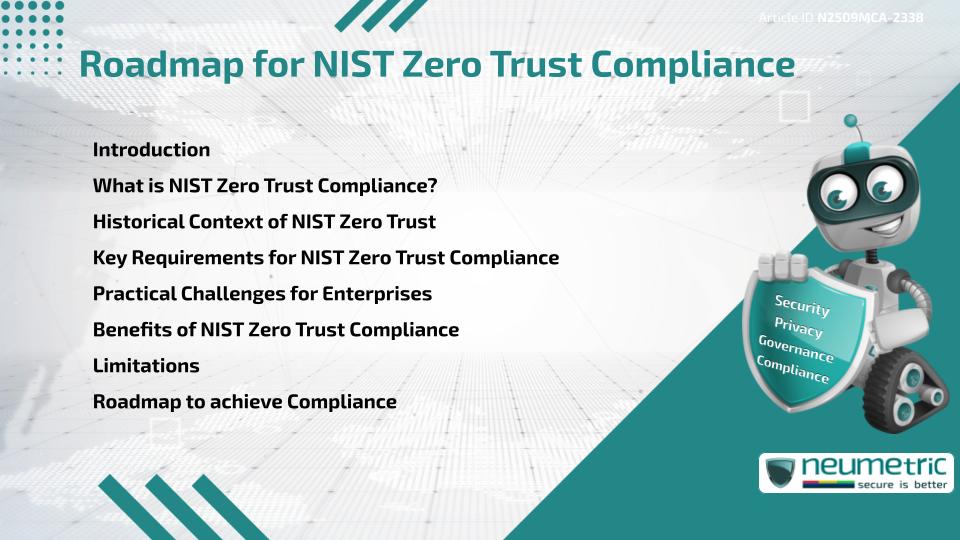Table of Contents
ToggleIntroduction
NIST Zero Trust Compliance is becoming a Top Priority for Enterprises aiming to modernise Security Strategies. Zero Trust, guided by the National Institute of Standards & Technology [NIST], moves beyond Perimeter based defences to a “Never Trust, Always Verify” model. Compliance ensures that organisations implement strong Identity, Access & Monitoring Controls aligned with NIST’s Zero Trust Architecture [ZTA].
What is NIST Zero Trust Compliance?
NIST Zero Trust Compliance refers to aligning Enterprise Security Practices with the Principles outlined in NIST SP 800-207. It involves Continuous Authentication, strict access Policies & Adaptive monitoring. Compliance demonstrates that Enterprises can Safeguard Resources even in Distributed, Cloud & Hybrid Environments.
Historical Context of NIST Zero Trust
Zero Trust Concepts emerged in the 2010s as Traditional Perimeter Defences proved ineffective against Insider Threats & Cloud-based Attacks. In 2020, NIST formalised Zero Trust Principles in SP 800-207, providing a Standard Framework for adoption. Since then, Regulators & Agencies have encouraged Enterprises to align with these guidelines, making Compliance a strategic requirement.
Key Requirements for NIST Zero Trust Compliance
Enterprises must meet Several obligations:
- Enforce strong Identity & Access Management with Multi-factor Authentication
- Apply Least Privilege Principles to minimise User & System Access
- Implement Continuous Monitoring & Adaptive Threat Detection
- Encrypt Sensitive Data In Transit & At Rest
- Document Policies that align with Zero Trust Principles
Practical Challenges for Enterprises
Adopting NIST Zero Trust Compliance can be complex. Enterprises with Legacy Systems may struggle to implement modern Identity & Monitoring Tools. High costs & resource constraints can limit smaller organisations. Coordinating Policies across Hybrid & Multi-cloud Environments also presents challenges.
Benefits of NIST Zero Trust Compliance
Despite these hurdles, Compliance offers clear advantages:
- Stronger resilience against Insider & External Threats
- Greater visibility into User Activity & System Behaviour
- Improved alignment with Regulatory & Industry Standards
- Reduced Risk of Large-scale Breaches & Data Loss
- Enhanced Trust with Customers, Regulators & Partners
Limitations
Critics argue that Zero Trust models may create Operational friction if Authentication processes disrupt User Experience. Others note that Compliance may not be achievable overnight, requiring phased adoption. Additionally, Compliance does not eliminate Risks entirely but instead reduces Attack Surfaces.
Roadmap to achieve Compliance
To achieve NIST Zero Trust Compliance, Enterprises should:
- Assess Current State: Conduct a Gap Analysis against NIST SP 800-207.
- Prioritise Identity: Implement strong identity Governance & Multi-factor Authentication.
- Segment Systems: Use Network Segmentation to limit Lateral Movement.
- Automate Monitoring: Deploy Tools for Real-time Analytics & Continuous Monitoring.
- Educate Staff: Train teams on Zero Trust Principles & Compliance Requirements.
- Leverage Global Frameworks: Align Practices with Resources like OECD Privacy guidelines & World Bank Governance insights.
Takeaways
NIST Zero Trust Compliance provides a Roadmap for Enterprises to Modernise their Defences. By adopting Identity-driven Controls, Continuous Monitoring & Adaptive Governance, organisations can build Resilience, strengthen Trust & Align with recognised Security Standards.
FAQ
What is NIST Zero Trust Compliance?
It is the alignment of Enterprise Security with NIST’s Zero Trust Architecture Principles.
Why is it important?
It strengthens Defences against evolving Cyber Threats & Builds Regulatory Trust.
What challenges do Enterprises face?
Challenges include Legacy Systems, High Costs & Complex Hybrid Environments.
What are Key Steps in the Roadmap?
Gap Assessments, strong Identity Governance, Segmentation, Monitoring & Staff Training.
Does Zero Trust eliminate all Risks?
No, but it reduces Vulnerabilities & Improves resilience significantly.
References
- NIST SP 800-207 Zero Trust Architecture
- NIST CyberSecurity Framework
- OECD Privacy Guidelines
- World Bank Digital Development
- ENISA – European Union Agency for CyberSecurity
Need help for Security, Privacy, Governance & VAPT?
Neumetric provides organisations the necessary help to achieve their CyberSecurity, Compliance, Governance, Privacy, Certifications & Pentesting needs.
Organisations & Businesses, specifically those which provide SaaS & AI Solutions in the Fintech, BFSI & other regulated sectors, usually need a CyberSecurity Partner for meeting & maintaining the ongoing Security & Privacy needs & requirements of their Enterprise Clients & Privacy conscious Customers.
SOC 2, ISO 27001, ISO 42001, NIST, HIPAA, HECVAT, EU GDPR are some of the Frameworks that are served by Fusion – a SaaS, multimodular, multitenant, centralised, automated, CyberSecurity & Compliance Management System.
Neumetric also provides Expert Services for technical Security which covers VAPT for Web Applications, APIs, iOS & Android Mobile Apps, Security Testing for AWS & other Cloud Environments & Cloud Infrastructure & other similar scopes.
Reach out to us by Email or filling out the Contact Form…


